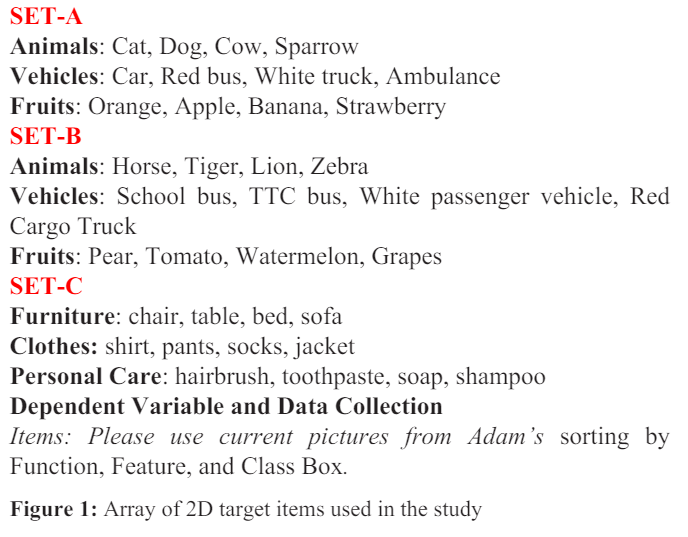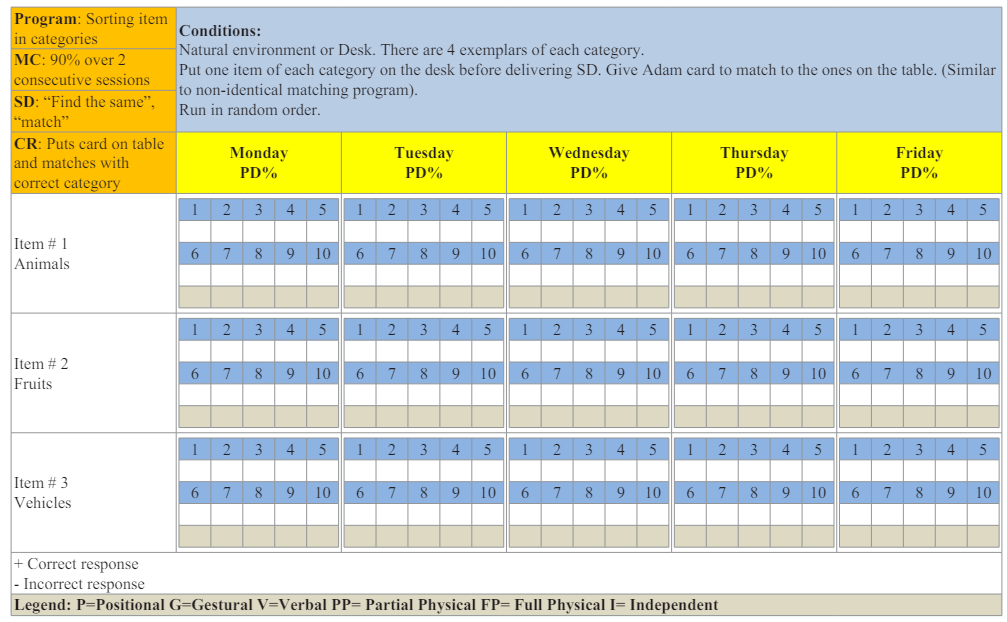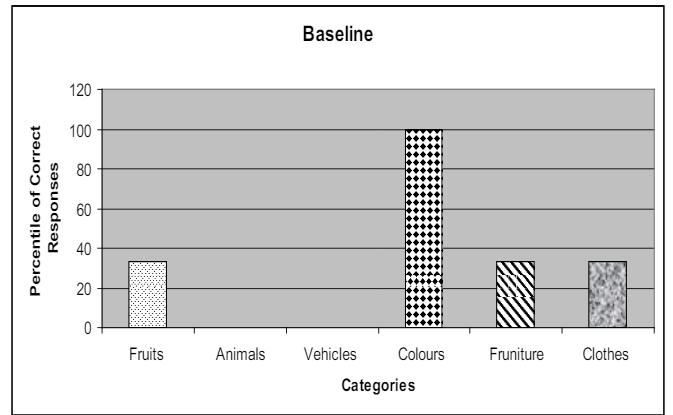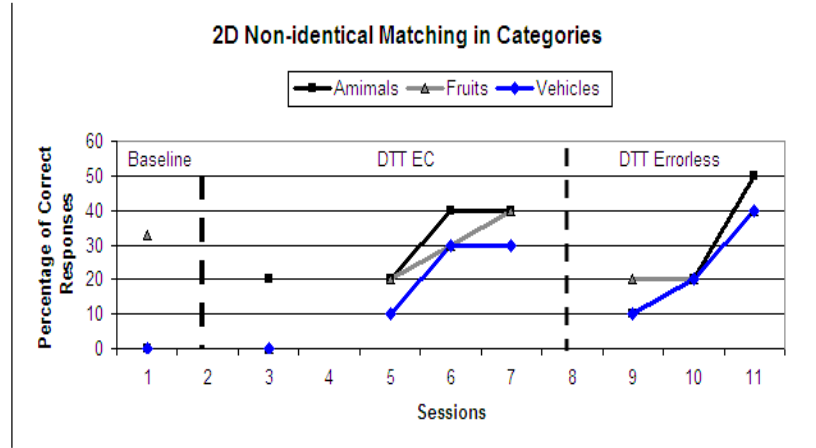Teaching a Child with Autism to Identify 2D Objects to Increase Receptive Language
Author'(s):Arshad Mahmood1* Irfan Mian2 and Tony Toneatto3
1Heartland Professional Services, Toronto.
2Hospital for Sick Children & University of Toronto, Toronto.
3Heartland Professional Services, Toronto.
*Correspondence:
Arshad Mahmood, 120 Traders Blvd. East, Suite 108, Mississauga ON L4Z 2H7 Canada.
Received: 20 Nov 2022; Accepted: 24 Dec 2022; Published: 30 Dec 2022
Citation: Mahmood A, Mian I, Toneatto T. Teaching a Child with Autism to Identify 2D Objects to Increase Receptive Language. Addict Res. 2022; 6(1): 1-6.
Abstract
Receptive language was targeted in a skill acquisition program to teach a six-year-old boy with autism to receptively identify 2D objects. The program involved teaching a set target list with various objects categorized under various everyday functions in the child’s life. The child was taught to identify objects in an array of three presented in front of the student. The program was run daily; generally, the trials were broken up into two sessions over the course of the morning. Once the child mastered the set of three objects, he would move to the next set of three objects. Mastered target objects were put onto maintenance schedules. The results demonstrate data from baseline, pretesting of a set of targets and skill acquisition over several weeks.
Keywords
Introduction
Children with Autism Spectrum Condition (ASC) often have severe language delays and deficits in receptive language making effective communication a challenge [1,2]. Children across the autism spectrum experience significantly delayed receptive and expressive language development [3,4]. Receptive language skills, the child’s ability to understand and act upon specific words and phrases, becomes an indicator of their ability to acquire other types of language [5]. Past research has generally found that children with developmental disabilities tend to acquire receptive language prior to expressive language although the research has not been consistent [6,7].
Symbolic understanding of word-picture-referent relations emerge at approximately 18-24 months in typically developing (TD) children [8,9]. Receptive responses are often taught by using the context of ongoing routines in a child’s life and reinforcing situations or items [5]. A word-picture-referent relation is here defined as the knowledge that a label refers to both the pictorial symbol and the real-world referent it depicts [10,11]. The program described in this study will focus on teaching the identification of items within the student’s environment and all targets will pertain to the child’s specific daily functional activities. As suggested by previous research, discrete trial teaching strategies have been implemented to teach a child to identify an item [12]. Following Sundberg and Partington [13], reinforcing items will initially be used within trials to promote identification acquisition. However, children with ASC often have specific difficulties understanding that words and pictures symbolically refer to objects [10]. Instead, they show associative mapping of word-picture-referent relations.
The initial use of continuous reinforcement which is then gradually faded into the use of a token board has proven to be effective [14]. Children with ASC often communicate using pictorial symbols as an alternative to speech [15-17] and demonstrate a relative strength in visuospatial processing compared to language [18]. Once acquisition criteria are met, a token board will be implemented into the program to motivate the child to identify various objects. It is also important that the child’s environment be a motivating one. Therefore, as other studies have explored, identification of objects will be generalized across settings to enhance receptive skills in various environments within the student’s daily activities [5]. The present project seeks to motivate the student with the incorporation of enticing objects and functional environments incorporating previous research of strategies for teaching receptive object identification [19].
Method Participant and Setting
Adam (not his real name), a six-year-old boy diagnosed with an autism spectrum disorder; received intensive behavioural therapy at a treatment centre specialized in the treatment of this disorder. Adam attends the centre every weekday morning and then attends school for the afternoon. Adam has been attending the facility for approximately three months. Adam is non-verbal and tends to communicate with screams or by pointing to items or objects that he wants. Adam has good attending skills as he can scan items and teaching material, will look at an instructor for instructions, and is able to sit and wait for reinforcement. Results of the Assessment of Basic Language and Learning Skills have shown that Adam can receptively respond to his name, receptively follow simple instructions, and has begun to touch items placed in various locations. These skills will be built upon with the implementation of the identification of 2D Objects Program [20]. Adam has also begun to develop visual performance skills such as matching. Such skills will be a prerequisite for identifying 2D objects. Adam has mastered matching identical pictures to a sample picture and can match up to 5 separate times in 15 seconds. Adam is a rapid learner and has mastered the task of acquiring new selection skills without intensive training. It was therefore judged that Adam would be able to learn this additional receptive communication skill.
Materials
All sessions during the program will require two chairs and a desk for Adam to work. In addition, an array of 2D target items will be needed with at least three exemplars of each item that will be used (see Figure 1).

The target objective for Adam is to be able to receptively identify 2D objects located within his environment. When given the

Figure 2: Daily Data Sheets.
discriminative stimulus by the instructor therapist “touch , or show me , or where is , or give me ” Adam will touch or give the instructor the target object at 90% accuracy (i.e., mastery) over two consecutive sessions. Upon mastery of the target set, the instructor therapist will move to the next target set in the list. The program is considered mastered when Adam can identify all items on the target list in multiple settings and with multiple instructors. The end goal of the program is for Adam to be able to identify any novel target items in an array of six items as shown in Figure 1.
Data will be collected in each session and after every trial. The instructor will record a positive (+) for each correct, unprompted response and a negative (-) for each incorrect or prompted response (see Figure 2). Data are summarized as a percentage of correct responses and are graphed daily (i.e., number of correct responses divided by the total number of trials per session). Revisions will be made to the program if data shows 5 consecutive points with no acquisition or a downward trend in the data.
Procedure
Baseline data will be collected to evaluate whether Adam had any prior receptive identification of objects skills. A set will be pre-tested before the teaching begins to determine whether he can already identify the object. To begin the program, the instructor will teach Adam to identify a set of three objects in an array of three in front of Adam in a row with a minimum of three exemplars (set 1). Further, an additional set of three objects in an array of three in front of the student in a row (set 2) will be presented. Once targets are mastered, the targets from set 1 and set 2 will be presented in a random array of three in front of the child in a row (set 3). These three sets will be repeated in the same way for all remaining objects in the target list. Once set A and B are mastered, they are moved to maintenance programming.
Sessions will be taught at the table and it is important to rearrange the array of objects after each trial in order to ensure the subject is not always identifying objects in the same location. It is also important to ensure that items within the set are visually and auditorily (i.e., do not sound the same) different. Errorless teaching will be used to teach the program, followed by the use of a most to least prompting procedure. Items being taught will be those easily located within the student’s natural environment and preferred targets will be used.
If the subject makes an error or incorrectly completes a previously mastered skill, the following error correction procedure will be used. The instructor will interrupt the error and prompt the correct response (physical prompting) followed by specific behavioural feedback such as “That is touching the ball, this is book”. The instructor will readminister the 2D Discriminative Stimulus and prompt, then correct response with the highest prompt level necessary to facilitate the correct response, followed by behaviour- specific verbal reinforcement (e.g., “Good touching the ball”). The instructor will administer a previously mastered target and re-administer the original discriminative stimulus and ask the subject to give the correct response independently. If the subject correctly identifies the correct object, the instructor will reinforce the student.
Reinforcement will initially be given on a continuous reinforcement schedule using tangible (in this case, edible) items such as candy. As acquisition is met, a token board will then be used to systematically fade the reinforcement schedule to a variable ratio 5 schedule. Adam is familiar with a token board and has used this form of reinforcement in other programs.

Figure 3: Data shows that the student has 33% accuracy for fruits, furniture and clothes and 100% accuracy for colours but 0% for animals and vehicles category.

Figure 4: Graph showed that at baseline, Adam obtained 33% accuracy. While in the second condition DTT EC (Error Correction), there was an increase for all the three categories. When the conditions changed to Errorless Training, there is initial decline for all three categories followed by an incline in all three conditions.
Results
Figure 3 shows the baseline while Figure 4 shows skill acquisition of identifying 2D objects. Each data point represents the percent of correct responses per session. The total numbers of trials per session divided the numbers of correct responses. Initially, baseline data was collected for all 42-target items with 33% accuracy. The first two items (Set A and B) pre-tested were mastered at 80% and therefore not taught to the child. The next set of three items (Set C) taught were pretested and 15% accuracy was obtained. Initially, the teaching for this set increased to 33% accuracy. By the fourth session, the student had acquired 83% accuracy, which decreased in the following session to 73%. A steady incline in acquisition was seen over the next four sessions, as results met criteria for mastery with 90% accuracy over two consecutive days. The next set of items was pre-tested, and 30% accuracy was seen. Data collection ceased after this point due to time restraints, however the program will continue to be run at the centre.
Discussion
Receptive language skills were used to teach a six-year-old boy with an autism spectrum disorder to receptively identify 2D objects. The child was taught to receptively identify an item within an array of three presented in front of him. Receptive language is said to increase a child’s ability to understand and act upon specific words or phrases; if completed, this is an indicator of the child’s ability to understand and acquire various language skills [5]. Adam’s responses showed that teaching receptive identification with both reinforcing and familiar items within one’s environment are shown to produce the most skill acquisition [5]. Adam successfully mastered a set of familiar and reinforcing items, progressing to identification of various other items within his environment.
Throughout the course of teaching the program, it was important for Adam to receive primary reinforcers to promote an increase in the responses given. He was able to choose which reinforcer, generally an edible reward, to work for. These reinforcer-sampling procedures were used due to the evidence showing that a reinforcer chosen by the individual may be more effective than an assigned reinforcer [21]. To prevent satiation, reinforcers were periodically changed throughout teaching.
Once skill acquisition is met, the mastered targets should be faded using intermittent reinforcement schedules to facilitate the maintenance of the skill acquisition by making the reinforcing contingency less discriminable [22]. Eventually maintenance programs will introduce a token economy, which will allow for mediators to award points for desirable behaviour in an effort to gain a reinforcer [21]. The emphasis then shifts from response acquisition to maintenance and from discrete-trial to free-operant methods [14]. Various studies have demonstrated the positive effect of using a token board, which tends to increase the level of acceptable behaviour and increase motivation for appropriate behaviours and responses [14]. The token board should be implemented once skill acquisition of the current set of targets has been met and the items are on a maintenance schedule. However, not all tokens are like this; some may use a tick on a sheet of paper, a hole punched in a card, or a stamp put onto a card. Non-physical tokens are sometimes called “points” [23].
Generalization has been well studied in the literature and is defined as the occurrence of relevant behaviour under different, non-training conditions, for example across subjects, settings, people, behaviours, and time [24]. Initially, it will be important for instructors to generalize the skills taught in various locations.
Adam should be identifying objects within various locations that are familiar within his environment. For example, if the object “knife” or “plate” is taught and mastered, Adam should be expected to identify a plate in a kitchen-setting, dining room setting or at a restaurant. Expanding this skill into the community will be beneficial to Adam for the future as he will be able to identify various needed objects within his daily activities regardless of where they are located.
The program has been designed to increase Adam’s receptive language skills. Therefore, the program will only be beneficial if the skills taught are maintained and generalized. In order to achieve this, Adam should be periodically tested to ensure that these skills are being maintained and are available in his repertoire [2,25-27]. Generalization of receptive language skills is better after an instructional history with a simultaneous method [5]. Maintenance trails should be run weekly; sessions can take place in various difference locations and be presented using novel instructor therapists. Further, as part of maintenance of the skill, mastered targets will be presented in an array of six to the students and identification of the objects with additional distracters present is expected to be maintained. This increase of the array will ensure that objects are easily identifiable; thus, skills will naturally generalize to the wider environment that is likely comprised of various distracters.
The current study reports findings like other studies examining generalization between receptive and expressive language in children with autism [28]. Adam is beginning to use the items, which he learned to identify in an expressive form. For example, Adam was able to ask for and label the item “puzzle” during an activity he was completing without being asked to use this expressive language. The skill of receptive identification can therefore eventually be paired with a labelling program; this will promote both receptive and expressive language acquisition. Additionally, the generalization must also take place across different instructors.
The importance of teaching receptive language to a child with autism has been studied and it is clear from the results that having receptive language in one’s repertoire is extremely beneficial. Understanding language through the identification of objects within one’s environment has begun and will continue to further develop expressive language. The program will continue to be implemented with various other target items, all promoting receptive identification of functional items within one’s environment.
References
1. Alzrayer N, Banda DR, Koul RK. Use of iPad/iPods with individuals with autism and other developmental disabilities: A meta-analysis of communication interventions. Review Journal of Autism and Developmental Disorders. 2014; 1: 179-191.
2. Lovaas OI. Teaching individuals with developmental delays: Basic intervention techniques. Pro-ed. 2003.
3. Anderson DK, Lord C, Risi S, et al. Patterns of growth in verbal abilities among children with autism spectrum disorder. Journal of Consulting and Clinical Psychology. 2007; 75: 594.
4. Wodka EL, Mathy P, Kalb L. Predictors of phrase and fluent speech in children with autism and severe language delay. Pediatrics. 2013; 131: e1128-e1134.
5. Grow L, LeBlanc L. Teaching receptive language skills. Behavior Analysis in Practice. 2013; 6: 56-75.
6. Abbeduto L, Short-Meyerson K, Benson G, et al. Relationship between theory of mind and language ability in children and adolescents with intellectual disability. Journal of Intellectual Disability Research. 2004; 48: 150-159.
7. Smith T, Groen AD, Wynn JD. Randomized trial of intensive early intervention for children with pervasive developmental disorder. American Journal on Mental Retardation. 2000; 105: 269-285.
8. Ganea PA, Allen ML, Butler L, et al. Toddlers referential understanding of pictures. Journal of Experimental Child Psychology. 2009; 104: 283-295.
9. Preissler MA, Carey S. Do both pictures and words function as symbols for 18 and 24 month-old children. Journal of Cognition and Development. 2009; 5: 185-212.
10. Hartley C, Allen ML. Brief report: Generalization of word- picture relations in children with autism and typically developing children. Journal of Autism and Developmental Disorders. 2014; 44: 2064-2071.
11. Hartley C, Allen ML. Iconicity influences how effectively minimally verbal children with autism and ability-matched typically developing children use pictures as symbols in a search task. Autism. 2015; 19: 570-579.
12. Charlop MH, Lang R, Rispoli M. Lights, camera, action! Teaching play and social skills to children with autism spectrum disorder through video modeling. Evidence-Based Practices in Behavioral Health. 2018.
13. Sundberg ML, Partington JW. Teaching language to children with autism or other developmental disabilities. Pleasant Hill. 1998.
14. Hackenberg TD. Token reinforcement: A review and analysis. Journal of the Experimental Analysis of Behavior. 2009; 91: 257-286.
15. Bondy A. PECS: Potential benefits and risks. The Behavior Analyst Today. 2007; 2: 127.
16. Kasari C, Patterson S. Interventions addressing social impairment in autism. Current Psychiatry Reports. 2012; 14: 713-725.
17. Jones RM, Lord C. Diagnosing autism in neurobiological research studies. Behavioural Brain Research. 2013; 251: 113-124.
18. Kumar SL. Examining the characteristics of visuospatial information processing in individuals with high-functioning autism. The Yale Journal of Biology and Medicine. 2013; 86: 147.
19. Simpson K, Keen D, Lamb J. Teaching receptive labelling to children with autism spectrum disorder: A comparative study using infant-directed song and infant-directed speech. Journal of Intellectual and Developmental Disability. 2015; 40: 126-136.
20. Partington A. The linguistics of laughter: A corpus-assisted study of laughter-talk. Routledge. 2006.
21. Alberto P, Troutman AC. Applied behavior analysis for teachers, 7th Edition. 2006.
22. Gansle KA, Noell GH, Freeland JT. Can't Jane read or won't Jane read? An analysis of pre-reading skills designed to differentiate skill deficits from performance deficits. The Behavior Analyst Today. 2002; 3: 161.
23. Chaudhary A. Token economy: important technologies of behaviour modifiers and applied behaviour. International Journal of Engineering and Management Research. 2015; 5: 497-504.
24. Gillett JN, LeBlanc LA. Parent-implemented natural language paradigm to increase language and play in children with autism. Research in Autism Spectrum Disorders. 2007; 1: 247-255.
25. Ganz JB, Flores MM. The effectiveness of direct instruction for teaching language to children with autism spectrum disorders: Identifying materials. Journal of Autism and Developmental Disorders. 2009; 39: 75-83.
26. Grow LL, Kodak T, Carr JEA. Comparison of methods for teaching receptive labeling to children with autism spectrum disorders: A systematic replication. Journal of Applied Behavior Analysis. 2022; 44: 475-98.
27. Gutierrez Jr A, Hale MN, O’Brien HA, et al. Evaluating the effectiveness of two commonly used discrete trial procedures for teaching receptive discrimination to young children with autism spectrum disorders. Research in Autism Spectrum Disorders. 2009; 3: 630-638.
28. Wynn JW, Smith T. Generalization between receptive and expressive language in young children with autism. Behavioral Interventions. 2003; 18: 245-266.